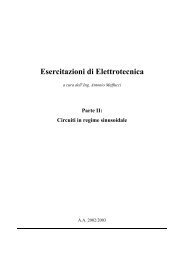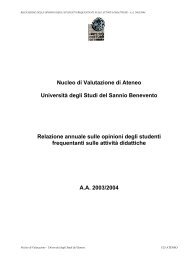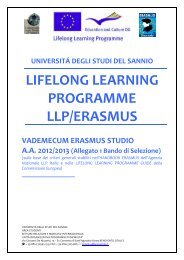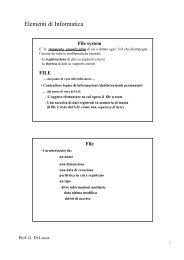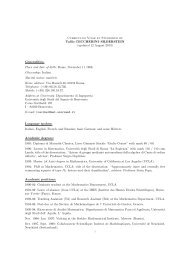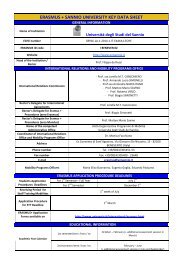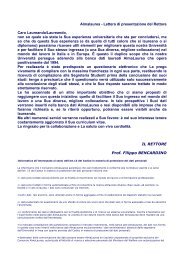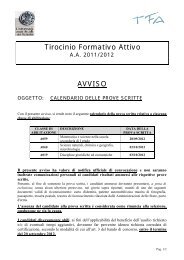Guida ECTS - Università degli Studi del Sannio
Guida ECTS - Università degli Studi del Sannio
Guida ECTS - Università degli Studi del Sannio
You also want an ePaper? Increase the reach of your titles
YUMPU automatically turns print PDFs into web optimized ePapers that Google loves.
Benvenuti a BeneventoWelcome to BeneventoLe testimonianze culturali più antiche esistentinel territorio di Benevento e <strong>del</strong>la sua provincia risalgonoall’età <strong>del</strong> paleolitico. I ritrovamenti archeologicidi palafitte, nel territorio di Castelvenere, enumerosi reperti ritrovati altrove testimoniano lapresenza <strong>del</strong>l’uomo preistorico in questa provincia.Riguardo alla nascita <strong>del</strong>la città di Benevento,la leggenda ne attribuisce la fondazione al miticoDiomede, approdato, dopo la distruzione di Troia,sulle coste pugliesi. Di sicuro si sa che fu abitatada popolazioni sannitiche, di ceppo sia irpino checaudino, per il ritrovamento di reperti culturali edi emergenze storiche come l’area archeologica dicontrada Cellarulo, che testimonia l’esistenza diuna popolazione stanziale, insediata alla confluenzadei fiumi Sabato e Calore, dedita alla lavorazioneed al commercio <strong>del</strong>la lana e di prodotti realizzaticon argilla.Florido centro <strong>del</strong>la civiltà sannita, entrò per laprima volta nella storia allorché i Sanniti, abili eaudaci guerrieri, sconfissero, nella battaglia <strong>del</strong>leForche Caudine (321 a.C.), il potente esercito romano,grazie ad un’abile mossa strategica <strong>del</strong> generalePonzio Telesino.PERIODO ROMANOI Sanniti, dopo le “Forche Caudine”, furono a lorovolta sconfitti e sottoposti al dominio di Roma dopola terza guerra sannitica (298-290 a.C). Il nome <strong>del</strong>lacittà, che anticamente era Maleventum, fu modificatodai Romani, con una forzatura etimologica, inBeneventum, a ricordo <strong>del</strong>la vittoria da essi riportatasu Pirro nel 275 a.C.Entrata così definitivamente nell’orbita di Roma,la città ne subì non solo la dominazione politicae militare ma anche e soprattutto quella culturale.Passaggio obbligato per raggiungere da Roma,percorrendo la Via Appia, le Puglie, Brindisi in particolaree, quindi, l’Oriente, divenne ben presto unimportante e strategico centro politico ed economico.I Romani, nel corso dei secoli, ebbero cura diabbellirla ed arricchirla di importanti edifici, tuttoraThe oldest cultural records in the Benevento areaand its province date back to the Paleolithic Age. Archaelogicalfindings of lake dwellings in the Castelvenerearea and several findings elsewhere recordprehistoric man’s presence in this province.With regard to the origin of the town of Benevento,legend has it that it was founded by the mythicalDiomedes, who landed on the Apulian coasts afterthe fall of Troy. Certainly, it is known it was inhabitedby the Samnites, from both the Irpino and Caudinolineage, due to cultural findings and historicaldiscoveries such as the archaeological area in Cellarulodistrict, which proves the existence of a permanentsettlement at the junction of rivers Sabatoand Calore, whose population was committed tothe production and trade of wool and clay.A flourishing centre for the Samnite civilization,it was reported for the first time in history when theSamnites, skilled and brave warriors, defeated themighty Roman army in the battle of the “Forche Caudine”(321 BC), thanks to a clever strategic manoeuvreby general Ponzio Telesino.THE ROMAN PERIODAfter the “Forche Caudine” battle, the Samniteswere in their turn defeated and, by the time of theThird Samnite War (298-290 BC), they were subduedby the Romans. The name of the town, whichwas originally called Maleventum, was changed intoBeneventum by the Romans, in order to celebratetheir victory over Pyrrhus in 275 BC.Thus, after being conquered by the Romans, Beneventoexperienced not only political and militarydomination, but also and above all cultural domination.The town was targeted by those travelling,along the Via Appia, from Rome to Apulia, especiallyBrindisi and, finally, the East; therefore, it soonbecame a key and strategic political and economiccentre. Over the centuries, the Romans madethe town beautiful and rich in important buildingswhich are still visible within the town’s walls, proofof its glorious past.BENVENUTI A BENEVENTO / WELCOME TO BENEVENTOHortus Conclusus: un particolare <strong>del</strong>l’opera di Mimmo Paladino/Hortus Conclusus: part of a work by Mimmo Paladino53



